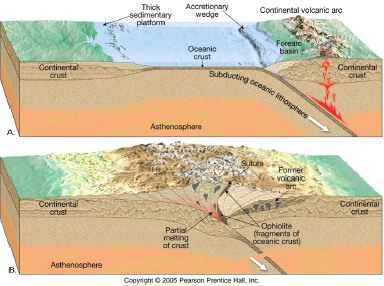How do continents grow by accretion?
1 Answer
Accretion is a process by which material is added to a tectonic plate or a landmass. This material may be sediment, volcanic arcs, seamounts or other igneous features.
Explanation:
There are two types of geologic accretion—plate accretion and landmass accretion (https://en.wikipedia.org/wiki/Accretion_(geology))
The first involves the addition of material to a tectonic plate. When two tectonic plates collide, one of the plates may slide under the other, a process known as subduction. The plate which is being subducted (the plate going under), is floating on the asthenosphere and is pushed up and against the other, subducting plate (see pic)
Much of the province of British Columbia, Canada where I live was formed by this process.
Sediment on the ocean floor will often be scraped by the subducting plate. This scraping causes the sediment to come off the subducted plate and form a mass of material called the accretionary wedge, which attaches itself to the upper, subducting plate.
Volcanic island arcs or seamounts may collide with the continent, and as they are of relatively light material (i.e. low density) they will often not be subducted, but are thrust into the side of the continent, thereby adding to it.
The second involves the addition of sediment to a coastline or riverbank, increasing land area. The most noteworthy landmass accretion is the deposition of alluvium, often containing precious metals, on riverbanks and in river deltas.

